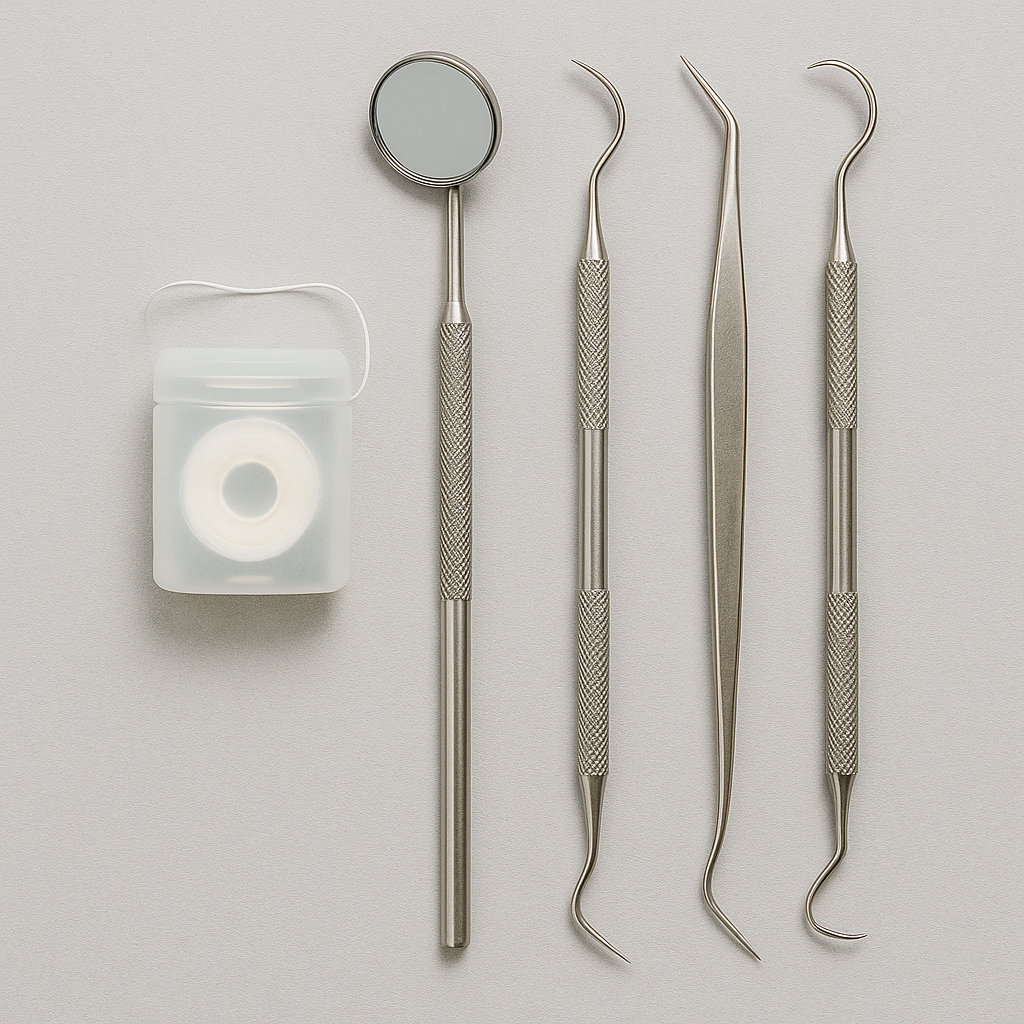Burs are a versatile dental instrument used across a number of procedures. But what are dental burs used for in modern dental practices?
They facilitate everything from cavity preparation to crown and bridge fabrication, cosmetic enhancements, and a whole lot more. These small but mighty instruments are crucial for tasks like shaping teeth, removing decay, and crafting precise fittings for prosthetics.
We’ll unpack all the common uses for dental burs below, leaving you with a clear understanding of not just their diverse capabilities but also how to choose the right bur for any given task. After all, with so many different use cases come a wide variety of dental bur types.
But no matter which style you’re looking for, remember that My DDS Supply is your trusted provider of premium quality dental burs online. With options ranging from carbide to diamond and a myriad of shapes and sizes, we’re here to empower you with the tools your practice needs at an unbeatable price!
What Are Dental Burs Used For?
Let’s not waste any time - what are dental burs used for, exactly? These workhouse instruments are the tool of choice from the basic removal of decay to intricate surgical applications, making them an integral component in your arsenal.
Cavity Preparation
Dentists use high-speed diamond or carbide burs to remove decayed tooth tissue efficiently in preparing for cavity work.
Diamond burs have an abrasive surface that is excellent for cutting through hard enamel, while carbide burs are effective in shaping dentin and creating a smooth cavity base and walls with their sharp flutes.
The choice between cross-cut and plain-cut designs depends on the need for fine or aggressive material removal. Whatever the case, precision in cavity preparation is crucial to prevent undercuts and ensure a proper fit for the filling material.
Crown and Bridge Fabrication
Burs provide precise contouring and finishing in crown and bridge fabrication. Diamond burs are commonly used for their ability to smoothly reduce tooth structure and adjust the margins for a precise fit of the crown or bridge.
Finishing burs are used as well, as these have a finer grit that refines the prep work to ensure a smooth surface. This is essential to optimize the seating of the restoration and minimize the adjustment required during fitting.
Root Canal Treatment
Endodontic burs are used during root canal treatment to access the pulp chamber and canals. These burs are designed to penetrate the tooth with minimal damage, providing a clear pathway for subsequent cleaning and shaping tools.
Choosing the right bur is important to prevent perforation of the canal walls and ensure the preservation of tooth integrity. This consideration influences the success of the endodontic treatment.
Periodontal Surgery
Surgical-type burs are used in periodontal surgery for bone reshaping and removal. These burs must be precise and minimally invasive, allowing for accurate modification of bone structure without causing unnecessary trauma.
Round burs or tapered fissure burs are commonly used for their efficiency in gently removing bone and smoothing surfaces to facilitate periodontal regeneration and healing.
Removal of Old Fillings and Prosthetics
Removing old fillings and prosthetics requires specialized burs that can cut through various materials, from amalgam to porcelain and composite.
Multi-fluted carbide burs are effective for amalgam removal, while specialized diamond burs are needed for harder materials like ceramics. The process must be done carefully to avoid damaging the underlying tooth structure, which is why dentists need burs that offer control and precision.
Orthodontic Procedures
You may be wondering, what are dental burs used for in orthodontics? There are two common scenarios - either to modify appliances or tooth structure to facilitate braces and other orthodontic devices.
Carbide burs are often used for their ability to precisely trim and shape metal components and for adjusting enamel to optimize the fit of bands or brackets. The right bur must allow for detailed work without affecting adjacent teeth or soft tissues.
Implant Placement
Specially designed implant burs are used to prepare the bone to the exact dimensions of the implant.
These burs create a precise and clean osteotomy, ensuring the stability and proper alignment of the implant. The process of placing an implant requires burs that can maintain sharpness and resist wear, even when cutting through dense bone.
Cosmetic Dentistry
Burs are often used for cosmetic procedures as well, such as veneer preparation, shaping composite restorations, and enameloplasty.
Fine-grit diamond burs are preferred for their ability to provide a smooth finish and precise shaping, both of which are essential for favorable aesthetic outcomes. These burs allow for effortless, meticulous modification of tooth structure to achieve the desired cosmetic effect.
Pediatric Dentistry
Pediatric dentistry involves using smaller-sized burs designed for children’s teeth. These burs are used for caries removal, cavity preparation, and minor adjustments.
The delicate nature of pediatric dental work requires burs that offer precision and minimal vibration to ensure comfort and prevent anxiety in young patients.
Quick Dental Burs Buyer’s Guide: Different Types and Tips on Choosing the Right Tools for Your Practice
Types of Dental Burs
There are two main types of burs for dental work from a material standpoint: carbide burs vs diamond burs. You’ll also find ceramic burs, but they’re particularly useful for patients with sensitivity to metal.
Dental diamond burs are known for their precision and cutting efficiency. They are ideal for fine and detailed work, especially in cosmetic dentistry, for shaping and smoothing tooth surfaces. Diamond burs come in various grits, from coarse for rapid material removal to fine for finishing touches
Dental carbide burs, on the other hand, are known for their sharpness and durability. They are often selected to shape and cut hard tissues, particularly in cavity preparation, the removal of old fillings, and adjusting prosthetics. They feature different flute designs that influence cutting efficiency and debris removal.
Across both styles you’ll come across a wide variety of shapes and sizes, with some of the most popular being:
- Round Burs: Ideal for excavation, removing carious material, initiating cavity entry, and endodontic access, providing a versatile solution for varied dental tasks.
- Pear Burs: Offer precision in removing minimal tooth structure, perfect for shaping cavity interiors and forming smooth, rounded internal contours in restorative procedures.
- Spiral Burs: Designed for surgical applications. They excel in cutting through bone efficiently, ensuring less trauma and smoother operation in procedures like implant site preparation.
- Flat Tapered Burs: Used for precise crown margins and creating flat, angled surfaces in tooth preparation, allowing for detailed and accurate shaping.
- Round Tapered Burs: Commonly utilized in crown preparation. They facilitate the creation of curved contours and are instrumental in sculpting occlusal anatomy and proximal access.
- Football Burs: Used for contouring and finishing occlusal surfaces. Effective in both amalgam polishing and soft tissue adjustments, ensuring smooth restorative finishes.
- Torpedo Burs: Known for their pointed, streamlined shape. These burs are adept at fine adjustments and finishing work in tight spaces, particularly between teeth.
- Inverted Cone Burs: Used for creating retention features in cavity preparations, these ensure mechanical locking in restorative dentistry, aiding in complex cavity designs.
- Fissure Burs: Straight fissure burs provide clean cuts for defining cavity outlines and sectioning teeth, while tapered fissure burs are tailored for precise crown and bridge preparations, establishing exact geometric angles
Factors to Consider When Choosing Dental Burs
Choosing the right dental bur for a given procedure influences your efficiency, the patient’s comfort level throughout the operation, and of course, the end result. Thus, it is not something you can take lightly.
So, how can you confidently pick the right bur for any use case? Here are a few factors to keep in mind:
- Procedure Type: The nature of the dental procedure dictates the bur type needed. For instance, diamond burs are preferable for precise enamel work, while carbide burs are better for removing decayed tissue. You should also consider the shape and size for accessing the treatment area and performing the task effectively
- Material Compatibility: Consider the material you'll be working with. For example, harder materials like ceramics may require different burs than those used for cutting through amalgam or composite.
- Speed and Torque Requirements: High-speed burs are essential for efficient cutting, especially in cosmetic procedures, while low-speed burs are better for more controlled shaping and polishing.
When in doubt, reach out. The experts at My DDS Supply are a click or call away ready to help you pick the perfect solution for your practice.
Maintenance and Care
Understanding use cases and choosing the right bur is a great start, but you also need to protect your investment and keep your tools in tip-top shape to ensure favorable patient outcomes.
Proper cleaning and sterilization are imperative to prevent cross-contamination. Follow the manufacturer’s guidelines for cleaning and use appropriate sterilization methods. Note that we have all the various dental sterilization pouches sizes you could need here at My DDS Supply as well.
It’s also important to store burs in organized and dedicated containers to prevent damage and maintain sterility. Even still, you should regularly inspect your instruments to assess their condition. You should never use dull or damaged burs, as this can compromise treatment outcomes.
If you do discover an issue with your burs, don’t stress. As we’ve said a few times throughout this guide, you can source all your burs right here in one place - My DDS Supply,
Find All the Dental Burs You Need for Unparalleled Precision at My DDS Supply!
Now that you know what dental burs are used for, it’s time you stocked up on all the different styles your practice needs here at My DDS Supply.
We’re your dedicated partner for all things dental located in Southern California and committed to providing the best products at unbeatable prices. With world-class customer service every step of the way, what more could you ask for?
Browse our catalog and discover our comprehensive range of dental burs, meticulously crafted to meet the diverse needs of dental professionals.
Whether you're seeking the precision of diamond burs for fine detailing and finishing or the durability of carbide burs for efficient cutting and shaping, we have you covered. Our inventory spans a vast array of types, sizes, and shapes, ensuring you find the perfect tool for every procedure.
We understand the urgency of timeliness in sourcing your instruments, which is why we dispatch all items within 1 business day post-purchase. If you have wholesale needs, you can count on us to deliver the best value for the money.
Beyond our burs, we have all the other tools and supplies that keep your world turning as a dental professional. That includes dental face masks, dental gauze, dental bibs, dental syringes, dental putty, dental sterilization pouches, and everything else.
So, choose My DDS Supply for your dental bur needs and experience precision, quality, and service that are simply unmatched as we wrap up our guide with a few parting thoughts below.
Wrapping Up Our Guide on the Uses For Dental Burs
What are dental burs used for? These indispensable dental tools are relied on for a variety of procedures, from cavity preparation to cosmetic enhancements. Differences in type, shape, and material allow you to target the application of your work, ensuring optimal outcomes for patients.
You can learn more about dental supplies in our blog with resources like how to soften dental putty, alginate impression errors, how to use rolled gauze, how long does temporary dental cement last, types of suction in dentistry, and more. Otherwise, there’s just one thing left to do - stock up on all the different burs you could need in your facility today!
With our commitment to customer service and prompt delivery, you can rest assured your practice is set up for success with the right tools on hand at all times. Shop with us for reliability and precision in every purchase.

